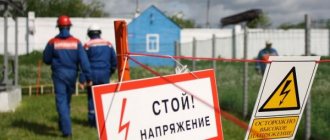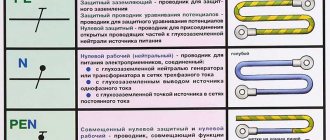At any enterprise, employees performing work using electrical equipment must have a special permit that allows servicing it. To obtain it, you must pass qualifying exams for assignment of an electrical safety clearance group. Each group corresponds to the range of production tasks that an employee is allowed to perform when working with electrical equipment or electrical installations.
Maintenance of electrical equipment by an electric welder with 2nd tolerance group
The scope of tasks solved by personnel in each group is regulated by the Interindustry Rules for Labor Protection (Safety Rules) for the Operation of Electrical Installations.
According to these Rules, there are 5 electrical safety groups. Group numbers are arranged in accordance with the increasing complexity of the tasks being solved by employees. They take into account education and experience working with electrical equipment.
Attention! Workers who are not electrical personnel can be assigned only groups 1 and 2.
The first is assigned to non-electrical personnel after instructions have been completed by a specialist of group 3. After this, the assimilation of the material is checked using an oral survey of employees. During the briefing, issues of the negative impact of electric current on the human body are discussed, as well as the rules for providing first aid to the victim. The results of the knowledge test are recorded in a standard journal.
To whom is it assigned?
Group II on electrical safety in enterprises and other structures is necessary for persons working with power tools or equipment. In accordance with regulatory documents, it is necessary to conduct training and test knowledge of the following categories of employees:
- If your work activity involves the use of power tools. For example, angle grinders, drills, hammer drills, screwdrivers and more.
- Riggers, slingers or persons associated with the operation of lifting mechanisms.
- When working on welding units.
- Management team, if there are persons under management who need to be assigned to the second group. This includes immediate managers, safety engineers, and mechanics.
It is important to know that these categories of people do not have the right to repair the instrument and check its functionality.
Categories of electrical technical personnel
In the occupational safety rules, all personnel are divided into several categories and each has its own functions:
- Administrative - technical. This includes persons supervising the work. Mainly the management team.
- Operational. Employees whose activities are related to the maintenance and operational management of tools or installations operating on current.
- Repair. These are workers who have the right to carry out repairs or maintenance, as well as carry out testing, installation and commissioning operations.
- Operationally - repair. These personnel are provided with the ability to perform maintenance and repair work.
Requirements for candidates
According to regulations, persons who need to undergo certification in areas of work activity and have access to the second group are subject to the following requirements:
- Coming of age.
- Experience in working with electrical appliances.
- Completion of training.
- Passing tests to the certification commission.
- Receive the certificate in hand.
After meeting all the requirements, the employee receives permission.
Personal certificate of qualification of a specialist
Practical dependence
One of the mandatory conditions for personnel qualification is an electrical safety group. To be awarded the appropriate qualification, you must undergo instruction and acquire practical skills. The fact of assignment is confirmed by the issuance of a certificate of the established form with a record.
TB requirements require a special approach and cannot be achieved without the experience gained during the internship. The employee’s work book must also indicate the access group. If it is necessary to issue an administrative document for the organization, then it is also required to indicate the date of certification.
When moving from one enterprise to another, be sure to keep the certificate; this document confirms the specialist’s skills when working with current and conductive equipment.
Responsibilities
An employee certified in the third group is assigned the following responsibilities:
- If it is necessary to work in electrical installations with voltages up to 1000 V, the employee can accompany the actions of personnel who need to perform functional tasks, but do not normally service technical devices.
- When replacing the electrical part, two employees must be present on the lifting mechanisms, since the work is carried out at height. One of the employees must have access to the third group.
- If the organization operates electrical installations with voltages up to 1000 V.
- Cleaning premises equipped with electrical installations with open switchgears with a voltage rating of up to 1000 V as directed by the manager.
The list of operations must be listed in the local act of the enterprise and approved by the chief engineer.
Types of knowledge tests
Testing employee knowledge is divided into areas in accordance with GOSTs and rules:
- primary;
- repeated;
- next;
- extraordinary.
A repeat check is carried out if the employee has not passed the tests under the program. In this case, a month is given for preparation and the commission takes the exam again.
Primary
Before directly performing production duties, persons whose activities are related to electrical equipment must undergo training and then pass exams.
If the duration of the break in work was more than 3 years, then it is necessary to re-train and be certified.
Next
Admission is granted for a year, and after this period the tests are required to be taken again, but for certain categories this period can be reduced. The protocol and certificate indicate the date of the next inspection.
Extraordinary
This type of certification can be carried out when the following circumstances arise:
- If changes or additions to regulations, including local ones, have come into force.
- After repair work or reconstruction of existing technical means and devices.
- If safety requirements are violated, it does not matter whether this situation led to an accident, accident or incident or not.
- At the request of higher authorities, for example, the Ministry of Labor or Rostechnadzor.
- If the break in work lasted more than six months.
Certain types of work permitted for the third group
Additionally, electricians with the third tolerance group are allowed to:
- Carry out voltage checks. On power lines together with another worker, and alone in switchgears.
- Install grounding buses, but only when an employee is included in the repair staff.
- Disconnect and install insulation on live elements. This work must be performed using PPE made from dielectric materials.
- Install high voltage warning posters and signs.
- Monitor the execution of operations related to the repair of current generating devices.
- Observe the condition of insulating means when measuring voltage.
- Perform routine repairs of batteries and generator under voltage.
When the voltage is above 1000 V, you can perform the following work:
- Clean areas with installed open switchgear.
- Maintain technical devices in accordance with established regulations.
- Monitor the drying process of transformer and generator installations, but when they are de-energized.
- Perform maintenance of oil purification units.
- Disconnect grounding blades.
The additional operations listed above are approved by the head of the organization.
How a group is assigned
Certification for permission to work in the second electrical safety group is carried out in accordance with regulations. For this purpose, a commission is created on the basis of an administrative document. Each member of the AC must have permission recorded in the certificate. A time is set for taking the exams and the opportunity to prepare is provided.
Where do they take the electrical safety group?
The exam is carried out at the enterprise, but only if there is a certificate to conduct it. If it is not possible to take tests on your own, then certification is carried out in specialized training centers that have permission to engage in this type of activity.
Who can take the exam
Knowledge testing is carried out on a commission basis. The minimum number of members must be at least three, including the chairman.
Basic conditions for creating a commission:
- If there are electricity receivers with a voltage of less than 1000 V, the chairman must have at least clearance group IV.
- If the voltage indicator is more than 1000 V, then the group assigned to the chairman must be at least V.
- The commission may include production site managers and occupational safety specialists.
- All members of the commission must have an electrical safety group of at least second.
- Certification of the chairman and members is carried out at Rostechnadzor or at the enterprise, but in the presence of an inspector.
Exam program for obtaining admission
Training is carried out according to the Program developed at the enterprise and approved by Rostechnadzor.
The training includes the following materials:
- Primary requirements.
- How is permission to work granted?
- List of technical documentation required for work.
- Concepts about electrical safety groups.
- Occupational health and safety during work.
- Actions in case of emergency situations: accident, incident, accident.
- Provide first aid until medical professionals arrive.
When preparing a program, you can use a standard one, and also take into account the specific capabilities of the organizational structure.
Training
Electrical Safety Exam
Knowledge is checked by commission and admission options are as follows:
- In the enterprise organization commission.
- In a specialized training center, and the composition should include an inspector from Rostekhnadzor, who monitors the safety during the operation of technical devices.
- Directly in RTN, geographically located.
The management of the organization appoints commission members to conduct certification. The chairman, as a rule, is the employee responsible for the energy management of the facility. All members of the commission must have certificates with a mark of certification.
Knowledge testing is carried out using tickets specially designed for the Training Program. Upon successful completion of the test, an entry is made in the protocol and a certificate is issued. If the certification is repeated, then a record of its completion is made.
Knowledge test result
The results of testing the knowledge and skills of employees are prepared according to the following algorithm:
- The training center of the enterprise or a third-party organizational structure approves the form of the protocol and certificate. The established forms of documents are placed in regulations.
- Information about passing tests is entered into the journal.
- Data on the inspection performed are recorded in the protocol: the employee’s surname and initials, job title, which electrical safety group was assigned, when the next certification is required.
- The results of passing the tests are entered in the certificate: the document number, the name of the enterprise, the surname and initials of the employee in full, his position when the document was issued are indicated; the date of the knowledge assessment, the reason for the event, which group was assigned, the assessment, the deadline for the next certification is indicated.
The certificate is issued to the employee.
Documents for certification
To test employees’ knowledge of electrical safety, the organization’s management writes an application to Rostekhnadzor. The following documents are attached to it:
- an extract from the Logbook for testing knowledge of working rules in electrical installations, as well as a protocol for testing knowledge of working rules in electrical installations - for employees who work at energy facilities;
- an extract from the Logbook for testing knowledge of working rules in electrical installations - for employees of organizations that are consumers of electrical energy.
Extracts are certified by the organization that sends employees for certification. For organizations that are consumers of electricity, certification is organized in specialized training centers; they do not have to contact Rostechnadzor.
Responsibilities of workers with the 2nd group of electrical safety clearance
Employees are not allowed to connect electrical equipment or carry out repair work on their own.
List of responsibilities:
- Know how to provide first aid.
- Know how to act in the event of emergency situations, including fires, accidents, and incidents.
- Report any malfunction or suspected malfunction of technical devices to your supervisor.
Do not start work without passing a knowledge test or without a break in work for more than 3 years.
Responsibilities
A specialist who has Group 3 electrical safety certification can perform certain administrative functions:
- allow the team to carry out work operations;
- control the actions of employees;
- carry out control and verification activities.
Professional job responsibilities:
- If necessary, to perform individual actions in installations (up to 1000 V), a specialist can attract and accompany personnel who do not service the relevant equipment in a normal manner.
- If lighting fixtures are being replaced at high altitudes using an overhead crane trolley as a support, then a team of at least two people is formed. One of them must have an electrical safety permit of 3 degrees. Such a specialist will perform work operations. A second team member is required to ensure regulatory safety procedures are followed.
- For work on installations up to 1000 V, it is enough to have group 3. To obtain the same rights when performing operations with equipment where the voltage is above 1000 V, you will need an electrical safety permit of 4 degrees. There are exceptions. For example, during an inspection alone, when an employee with group 4 belongs to the administrative and technical, and not to the operational personnel, it is allowed to work only with installations up to 1000 V. The right to such an inspection must be documented.
- An employee with group 3 can perform work as directed (voltage in electrical installations up to 1000 V). Without accompanying persons, he is allowed to clean the territory of open distribution devices.
You can also:
- Check that there is no voltage. In switchgears - alone, on overhead lines - together with a partner.
- Install and remove grounding structures when included in the operating personnel.
- Disconnect and install insulating connections on current-carrying elements of electrical installations. These works must be carried out using personal protective equipment (gloves made of dielectric material).
- Install posters in open switchgears warning about the presence of voltage and the prohibition of passage along certain paths.
- Supervise the grinding of rotor parts and some other generator maintenance operations by an employee who is not part of the specialized (electrical) personnel.
- Monitor insulation when performing measurements and tests without the presence of the manufacturer.
- Perform routine maintenance of the brush assembly of the generator when it is turned on; rechargeable batteries.
- At a voltage of more than 1000 V with 3 g. Electrical safety clearance alone is allowed:
- Carry out cleaning activities at the site where open switchgear is installed.
- Troubleshoot, carry out routine maintenance of structures, reception and transmission of information, lighting devices and their power supply networks during work operations at a height of up to 2.5 meters.
- Monitor the drying process of generating and transformer equipment (the equipment is turned off).
- Maintain oil purification units.
- Disconnect grounding blades and disconnect portable devices with similar functions.
- If a person who is allowed to work on electrical installations simultaneously performs the duties of a manufacturer, then he must carry out preparatory operations together with a specialist with group 3.
Joint execution of electrical work
- When, in the process of completing a task, it becomes necessary to leave the switchgear room, an employee with 3 gr. electrical safety approval. He is also appointed in such situations to accompany an employee with less qualifications. 2.
The information listed in this section is used when drawing up official job descriptions indicating electrical safety clearance, for the correct organization of work processes in commercial and government enterprises.
SAFETY REQUIREMENTS FOR OPERATING ELECTRICAL EQUIPMENT
5.1. Equipment with external power supply, depending on the method of protection against electric shock, is divided into class IV: - electrical equipment of safety class I, in addition to basic insulation, has a grounding contact of the power cord plug or a clamp on the housing with a permanent connection to the network, which serves to connect those accessible to touch metal parts to an external grounding device; — devices of safety class 0I, in addition to basic insulation, have a clamp for connecting accessible metal parts to an external grounding device; the power cord plug does not have a grounding contact; — electrical equipment of safety class II (with double or reinforced insulation, has, in addition to the main insulation, additional insulation, a sign at the entrance of the power cord into the housing) and does not require protective grounding or grounding; — class III devices are powered from an isolated current source with an alternating voltage of no more than 24 V or a direct voltage of no more than 50 V and do not have circuits with a higher voltage and do not require protective grounding or grounding. 5.2. If the degree of protection (class) is not indicated in the markings on the equipment or in the operating instructions (passport) or they are lost, then such devices must be checked by engineering and technical personnel to determine their suitability for further safe operation. It is prohibited to allow the use of such devices by customers (for example, refrigerators) if the degree of their protection is unknown. 5.3. To protect against electric shock, all accessible metal parts of Class I and Class 0I equipment must be grounded or neutralized. 5.4. The continuity of the circuit between the protective grounding terminal on the electrical installation and the grounding terminal on the panel or protective grounding bus must be checked by personnel inspection at the beginning of each work shift. It is prohibited to supply mains power to the electrical installation if the continuity of the protective grounding circuit is broken. 5.5. In the room where electrical equipment is operated, radiators and metal pipes for heating, water supply, sewer and gas systems must be covered with wooden gratings or other dielectric barrier devices, and the floors must be non-conductive. 5.6. Personnel are prohibited from connecting electrical equipment to the network if the insulation of the power cord and plug body is damaged, as well as other defects that may cause personnel to touch live parts. 5.7. If a malfunction is detected during the operation of electrical equipment, personnel must immediately disconnect the faulty device from the network and report this to their immediate supervisor. 5.8. It is prohibited to work with faulty equipment; work can be resumed only after the fault has been eliminated and there is a corresponding entry in the maintenance log by the person responsible for the serviceability of the electrical equipment. 5.9. It is prohibited to disconnect electrical equipment by pulling the plug from the socket by the cord; force must be applied to the body of the plug. 5.10. It is prohibited to transport carts over wires and cables, to step on electrical cables or cords of electrical equipment, to carry running electrical devices or leave them plugged in without supervision, or to throw plugs on the floor. 5.11. When connecting stationary equipment, the use of adapters and extension cords (except for special stabilizing devices) is prohibited, for which a sufficient number of plug sockets must be provided in the premises. 5.12. Workers are prohibited from using electrical equipment without first familiarizing themselves with the principle of its operation and the rules of safe operation (passport or instructions). 5.13. It is prohibited to check the functionality of electrical equipment in rooms that are not suitable for use with conductive floors, damp, and do not allow accessible metal parts to be grounded (for classes 0I and I). 5.14. Personnel are prohibited from independently repairing faults in electrical equipment; repairs are carried out by a worker with the required qualifications and only after disconnecting the device from the network. 5.15. It is prohibited to use electric stoves with open spirals, electric heaters without protective enclosures, and other electrical receivers with live parts that can be touched indoors. 5.16. It is prohibited to place the wires of portable lamps and electrified tools on wet surfaces, hot objects, or in places where they may be subject to friction, twisting, or tension. Wipe electrical installations connected to the network with wet rags. Wash the walls where electrical appliances are installed, cables and wires are laid. Clean the premises using a watering hose near the switchgear and electric motors installed on the floor.










